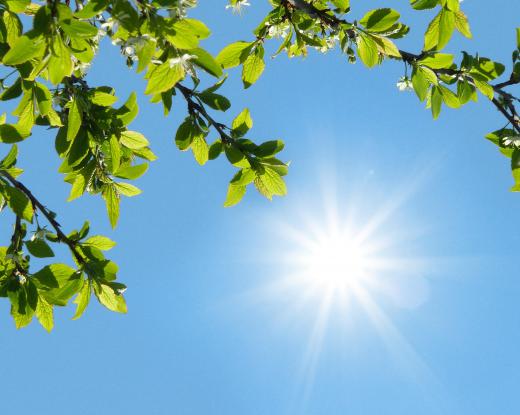What is a Sunshine Recorder?
 Dee Saale
Dee Saale
A sunshine recorder is a device that measures how much sunlight a certain region or area is receiving at any given time. There are a couple of different types of recorder, often with slightly different specifications. The ways in which they work can be different, too, but the end result is usually about the same: namely, to get an accurate and dependable solar input reading. Most of these sorts of devices are more or less permanent. They may be technically portable, but in most cases they’re used to collect readings in the same place over a long period of time such that averages can be tabulated and comparisons made from month to month, year to year, and decade to decade. Researchers use this data for all sorts of things. Weather predictions and heat indexes are some of the most common applications, but solar output readings are also important to things like architectural efficiency and building considerations. The most accurate and dependable recorders tend to be quite bulky and are often very expensive, but smaller readers are increasingly becoming available for more casual users.
Basic Concept

The sun provides most of the critical energy needed to sustain life on earth, and it is a powerful force. Solar radiation isn’t uniform everywhere, though. The earth’s distance from the sun at different times of the year plays a part, certainly, but there are also a number of other factors — the energy absorbency of nearby materials, the density of the natural landscape, and so on — that can impact the total amount of radiation that penetrates a given location. The main idea behind a sunshine recorder is to quantify solar energy as it strikes the earth, and measure both its strength and volume.
Marvin Recorders
There are several different tools researchers can use to get solar readings. One of the oldest is the Marvin recorder. This device is powered by a chronograph clock and operates with the help of two tinted light bulbs, and it works by measuring heated air pressure inside the bulbs, which in turn forces mercury within a compressed tube in much the same fashion as a thermometer. In this way, the device converts the change to a meaningful and traceable number that can be used by researchers and scholars. This sort of device usually works best in direct sunlight, though it can still read most radiation on cloudy or overcast days. These readings aren’t always as accurate, though.
Campbell-Stokes Recorders
One way that the duration of sunlight is measured is through a Campbell-Stokes sunshine recorder. This is one of the most widely used devices in the category. It is comprised of a glass canister or sphere that directs sunlight onto a card that is treated with a special chemical. The sunlight burns or chars a mark onto the card. This marking, called a trace, is measured and converted into a duration of time.
The card is typically changed once a day. It is relatively accurate and provides a total duration of sunshine to the nearest tenth of an hour every day of the year. The sun changes elevation several times throughout the year, and in most cases there are also three different cards that can be used. The cards are associated with the different seasons and are created to fit with the elevation of the sun.
Blake-Larsen Recorders
Devices known as “Blake-Larsen” recorders tend to be some of the most technologically advanced. These are powered by computer software programs and most will translate their results directly to websites or web-hosted databases almost instantaneously. The actual processing is similar to the Campell-Stoke model, but the way in which the results are tabulated and reported is often really different.
These sorts of recorders are often really popular with governmental weather agencies as well as with private interest groups who want to monitor radiation in a given place. Architects and engineers are also usually interested in the nearly-instantaneous results of these sorts of readings, as they can help determine the best places to build and the most advantageous placement for things like solar paneling.
Less Intensive Models
The electronic solarimeter is a newer, smaller, and simpler device that has a similar purpose. It can read the intensity of solar radiation and expresses its data in watts per square meter. In general, solar radiation can be in one of two forms: direct or diffuse. If it is direct radiation, the radiation reaches the solarimeter directly from the sun. In the case of diffuse radiation, though, it reaches the solarimeter after it is scattered by dust, particles in the atmosphere, and gas molecules. Readings from these and similar devices aren’t always as precise or as detailed as those from more intensive recorders, but for more casual purposes they can work just as well at a fraction of the cost.
AS FEATURED ON:
AS FEATURED ON:











Discussion Comments
@cougars- Diffuse and direct solar radiation are very important to solar energy. Solar thermal systems used for water and space heating can effectively use diffused solar radiation by absorbing the heat from said radiation. Solar thermal collectors used to generate electricity, on the other hand, cannot use diffuse radiation to generate electricity since they concentrate beams of direct solar radiation to heat water and run a turbine or stirling engine.
Photovoltaic systems, on the other hand, can generate electricity with diffuse solar radiation, although the amount of energy produced falls off. This allows PV systems to effectively generate electricity in partly overcast conditions. I hope this helps explain types of solar radiation, and how they affect solar energy.
@Cougars- Sunshine recorders, wind meters, and other climate devices are actually quite expensive. A Campbell-Stokes Sunshine Recorder can run upwards of $3000 and is quite bulky to carry. Much more equipment than would be needed for a fun day in the park. I would suggest printing up some solar radiation maps for your city or state, and buying a small solar panel kit.
I used to have one when I was a teenager that allowed me to make a small solar array that powered a fan. I installed it on the side of my tree house to give me a little ventilation. You can find a decent kit for less than $100 and it might inspire your children to learn more about solar energy. My parents bought me all types of science kits and toys as a child, and now I am an environmental scientist studying renewable energy and resource management.
I have heard of instruments used to measure wind speeds, but I did not know there were specialized instruments to measure solar radiation. Does it matter if the solar radiation is direct or diffused when it comes to solar energy? How much solar radiation is necessary to install solar panels? Where can I find a sunshine recorder? I would be interested in taking my kids to the park to take sunshine readings and teach them about the solar energy.
Solar readings are also important for those planning to install residential, commercial, or utility scale solar arrays. Solar radiation intensity (basis of solar insolation) is measured in Watts per square meter. A survey is conducted that uses sunshine recorders to determine the solar insolation of an area. Solar insolation is essentially the amount of energy in a given area per day.
The standard measure for solar insolation is given as kilowatt-hour, per square meter, per day (kWh/m^2/day). The insolation tells solar technicians what collector area would be necessary to achieve a certain power output. There are a number of charts that can be used for smaller installations that give the average insolation over a period of years, but utility scale installations will use their own surveys conducted over a certain period.
An average annual insolation of 5.5 would be considered very high, only being found in Phoenix, Los Angeles, and Honolulu within the United States. On the other hand, a solar insolation of 5.5 for the summer months would be considered low. In the lower 48 states, solar insolation levels range from 0.9 in the winter to 7.7 in the summer.
Post your comments